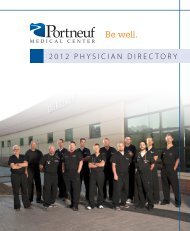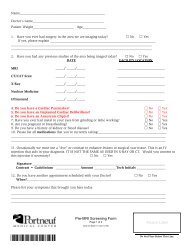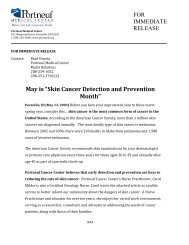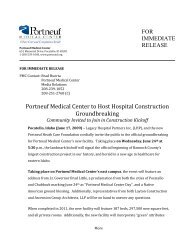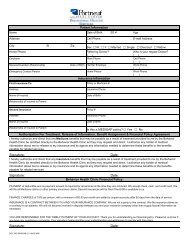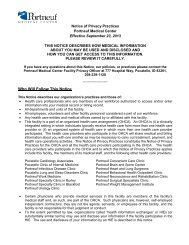Download Collection Information - Portneuf Medical Center
Download Collection Information - Portneuf Medical Center
Download Collection Information - Portneuf Medical Center
- No tags were found...
Create successful ePaper yourself
Turn your PDF publications into a flip-book with our unique Google optimized e-Paper software.
Directory of Pathology Services andSpecimen <strong>Collection</strong> ManualIntroductionGeneral <strong>Information</strong>Idaho Pathology Laboratory provides pathology services to <strong>Portneuf</strong> <strong>Medical</strong> <strong>Center</strong>, Pocatello,Idaho.<strong>Portneuf</strong> <strong>Medical</strong> <strong>Center</strong> provides services in areas of surgical pathology, cytopathology, flowcytometry, hematopathology, forensics, immunohistochemistry, and molecular diagnostics.<strong>Portneuf</strong> <strong>Medical</strong> <strong>Center</strong> operates sections in surgical pathology, cytology (gyn and non-gyn),and histology.Mission StatementTo improve the health and quality of life of the patients and communities we serve by providingthe highest quality laboratory services by means of state-of-the-art technology and soundbusiness practices.TechnologyThe Surgical Pathology Laboratory and staff have access to a wide variety of ancillarytechniques including immunohistochemistry, special stains, fluorescence immunopathology, flowcytometry, and molecular diagnostics. These ancillary services are performed to ensure optimalturnaround times for patient care.I. Leica Automated conventional tissue processor2. Leica Bond machine for immunohistochemistry with approximately 40 antibodies3. Digital cameras for macroscopic and microscopic pictures4. Nova Path reporting system for surgical pathology and cytology reports
Pathology Client ServicesService Commitment<strong>Portneuf</strong> <strong>Medical</strong> <strong>Center</strong> believes in working closely with our clients to ensure quality patientcare as well as client satisfaction. Our primary goals are to offer superior testing andpersonalized service through building professional relationships with our clients. <strong>Portneuf</strong><strong>Medical</strong> <strong>Center</strong>’s service commitment is to exceed the needs of its customers and support itsclients in their own delivery of service.IntroductionSurgical PathologyThe Surgical Pathology Laboratory offers general community services with advancedtechniques in a wide variety of organ systems. The surgical pathology staff includes RoshanPatel, MD, Kristopher McGee, MD, and Charles Garrison, MD. All pathologists are certified bythe American Board of Pathology. Dr Charles Garrison is a board certified forensic pathologist.Turnaround Time• For routine specimens not requiring special techniques, a written report and telephoneconsult can usually be provided within one to two business days.• For specimens where immunohistochemistry is required, a written report and telephoneconsult can usually be provided within three to four business days.For specimens where advanced diagnostic techniques are required (such asmolecular studies), a written report and telephone consult can usually be provided within 7 to 10business days.Dr. Kristopher McGee, MDEmail: kmcgeemd@gmail.com773-957-8644Dr. Roshan Patel, MDEmail: roshanspatel@gmail.com773-802-1100PATHOLOGISTS
Dr. Charles Garrison, MDEmail: chickg@mac.comOffice:<strong>Portneuf</strong> <strong>Medical</strong> <strong>Center</strong>777 Hospital WayPocatello, ID 83201Pathology: 239-1690FAX: 208-239-3711PMC Laboratory: 239-1671After Hours:773-802-1100773-957-8644Specimen Handling InstructionsAll specimens prepared for transport should follow these general instructions:Diagnostic SpecimenA diagnostic specimen is defined as any human, including but not limited to: excreta, secreta,blood and its components, tissue and tissue fluids, being transported for diagnostic purposes.Specimens should be considered diagnostic specimens and sent under IATA PackingInstructions #650, unless the specimen is known to be an infectious substance.Infectious SpecimenAn infectious substance is defined as a viable microorganism, or its toxin, that causes or maycause disease in humans or animals, and includes those agents listed in 42 CFR 72.3 or theregulations of the Department of Health and Human Services and any other agent that causesor may cause severe, disabling, or fatal disease.
Specimens which are known or thought likely to contain infectious material must be packaged orsent separately following lATA Packing Instructions #602. Infectious specimen quantity must notexceed 50 mL.Sending Specimens to <strong>Portneuf</strong> <strong>Medical</strong> <strong>Center</strong>:Specimen Transport Instructions1. Complete a separate pathology request form for each patient (Histology or Cytology,as the case may be).2. Be sure to record the following:a. Patient name, birth date, gender, and SSNb. Insurance and / or billing information including name of the insured, subscribernumber, group number, name and address of insurance company and IPA group(if applicable)c. Site and type of biopsyd. Request for any special stains or studiese. Copy (front and back) of patient’s insurance cardf. <strong>Collection</strong> date and timeg. Type of specimenh. Clinical history --- include a copy of prior pathology report if relevant3. Mark box (es) indicating the test(s) requested4. Print patient name and tissue source / location legibly on each specimen container,(not on the lid)5. If re-biopsy of a lesion, please provide date and the specimen accession number ofprevious biopsy.A completed Surgical Pathology requisition with clinical history must be submitted withall cases. Please provide as much clinical history as possible, including history of priormalignancies. This information is important to the interpretation of the lesion and may help inselecting the appropriate special stains and tumor markers needed to make an accuratediagnosis.
Specimen PreservationBiopsy specimens1. Gross tissue specimens must be submitted in 10% neutral buffered formalin withenough fixative to cover the specimen. Specimen containers must be securely tightenedto eliminate any leakage and must also display the OSHA required FORMALDEHYDEcautionary information.2. For H & E slide consultations, specimen submission should include special stainedslides, and / or paraffin blocks. Most special stains can be performed on conventionalparaffin sections. Paraffin blocks are preferred for immunoperoxidase studies. Ifmercurial fixatives such as 85 are used, this should be designated on slides or blocks.3. The following specimens should be substituted immediately WITHOUT FIXATIVE andmay require special processing.A. Frozen sectionsB. Lymph nodes (place in RPMI solution)4. It is best to confer with a pathologist concerning requests out of the ordinary prior tosubmission of the specimen.Fluid specimens1. Fix by mixing with equal amounts of 95% ethanol or 70% isopropyl alcohol (availablein the hospital surgical area).A. Bladder washingsB. Bronchial wash fluid and lavage fluid – Do not add fixative. Refrigerate.C. Spinal fluidD. Pleural and ascetic fluidE. Synovial fluidBiopsy: Bone MarrowF. Breast cyst fluidBone marrow biopsies are a send – out test to Genoptix <strong>Medical</strong> Laboratories. Handling shouldbe done in accordance to Genoptix protocols.Comment: Bone marrow biopsy specimens are performed for a variety of reasons ranging fromevaluation of anemia to the diagnosis of metastatic carcinoma and leukemia. Complete patienthistories, as well as documentation of any supporting details are vital to the complete andaccurate interpretation of the material.
Routine Cervical, Endocervical, Endometrial Biopsies1. Provide clinical history, i.e. last menstrual period, prior biopsies or pap smearinformation, and any history of hormone use including birth control pills on the requisitionform.2. Immediately place the specimen in the fixative container, tightly close container lid,and forward to the laboratory with the requisition.3. Use of gauze pads to hold or place endometrial and endocervical sampling isdiscouraged because portions of the specimen are absorbed into the coarse weave andlost. Telfa is acceptable; placing the specimen directly into formalin is preferred.Biopsy: Cone and Leep Conization of Cervix1. Include on the requisition a history of prior pap smear or biopsy results.2. If necessary, orient cone specimen with surgical suture material.3. Immediately place the specimens in the fixative container, tightly close container lidand forward to the laboratory with the requisition.Biopsy: Routine and Skin Excisions1. Include any history of or gross description of lesion and history of previous biopsies ifavailable,2. Orient specimen as necessary using description or surgical suture material3. Place the specimen in the fixative container and forward to the laboratoryComment: Each biopsy should be placed in a separate container labeled with the site of biopsy.The consequences of submitting skin biopsies of several sites in a single container can bedisastrous. Many dermatologic disease processes look similar microscopically. Pleasedescribe the lesion in detail, and provide as much clinical history as possible. Providing thisinformation will help our pathologist to be very specific with his / her diagnosis.Lymph Node for Flow Cytometry1. Do Not submit in formalin. Instead submit in RPMI fluid. Complete requisition andinclude primary care physician or oncologist.2. Specimen should be received within 30 minutes for optimal resultsLymph nodes other than for flow cytometry should be submitted in 10% formalin for routinestudies
Biopsy: Prosthetic Breast Implants1. The prosthetic breast implants must be submitted in separate containers withoutfixation.2. The fibrous tissue capsules may be submitted separately in 10% formalin.3. Indicate on the requisition the presence or absence of prosthetic rupture or leakage.Comment: Please indicate if these specimens are to be returned to you or the patient. A signedrelease form from the patient must accompany the request for return of specimen for medicallegal purposes.NOTICE: We have discovered that formalin fumes are extremely detrimental to cytologyspecimens. Many smears have been ruined because of exposure to formalin. Thisexposure often occurs during transportation when smears are shipped in the samecontainer with biopsies.We recommend shipping cytology and surgical specimens in separate specimen bags tominimize this potential problem.For cell surface marker studies by flow cytometry, fresh tissue is desirable for improvedpreservation of antigens. The tissue should be placed in RPMI.Arrangements for shipping and specimen containers can be made by contacting the pathologydepartment at (208)239-1690.Specimen Labeling PolicyTo assure positive identification and optimum integrity of patient specimens from the time ofcollection until testing is completed and results reported, the client must label all specimenssubmitted for testing with the patient name and tissue source. <strong>Portneuf</strong> <strong>Medical</strong> <strong>Center</strong> samplesfrom the same patient on the same day should also be labeled with the time of collection.Clients will be notified of inappropriately labeled specimens and the specimen will be returned tothe client upon request.Packing Requirements1. Place the specimen in the zip lock portion of the specimen bag.2. Fold completed requisition in half, and place the form in the outside sleeve of thespecimen bag.3. Ship one anatomic pathology specimen per bag.
ContainersTo ensure safe handling procedures, non-compromised specimens, and to provide qualitypatient care, including fast and accurate test results, we request that <strong>Portneuf</strong> clients use thefollowing guidelinesAcceptable Containers<strong>Portneuf</strong> Standardized containersUnacceptable Containers/ ConditionsThe following will not be accepted because of safety and biological contamination issues:• Leaky specimens that are not placed in a secured secondary container or leaking insuch a way as to compromise testing• Syringes with needles attached• Transfer tubes secured with parafilm or paraffinHours of OperationRegular work hours are 8:00 a.m. to 4:30 p.m., Monday through Friday. After hours; please seethe pathology call schedule if in need of a pathologist.Requisition FormsHistology (Surgical) Requisition Form - Exhibit AIntroductionCytopathologyThe Cytopathology Laboratory is a full-service laboratory, providing routine screening anddiagnostic testing of all non-gynecologic, and fine-needle aspiration specimens. Our mission isto provide cytopathology service of the highest possible quality to clients and providers, as wellas their patients.Non-Gynecologic CytologyThe Cytopathology Laboratory provides non-gynecologic cytology services (including theevaluation of the following specimen types):
Fixation:I. Pulmonary: sputum, bronchial brush / wash and broncho-alveolar lavage (includesevaluation for opportunistic infections with Gram, AFB, and GMS stains; cell count anddifferential also available)2. Urologic: urine (voided, catheterized, or instrumented), bladder wash, ureteral / renalpelvic wash / brush3. Body Cavity Fluids: pleural, pericardial, pelvic wash, synovial4. Cerebrospinal Fluid (includes cell count and differential for malignant CSFs forpurposes of monitoring treatment)5. Gastrointestinal: oral cavity / esophageal gastric brush / wash, bile, biliary systembrush6. Other Sources: nipple secretion, skin scraping (including Tzanck smears for detectionof herpetic infection)General Requirements1. For cytological specimens, immediate fixation is essential for cytological examination.Air-drying begins as soon as the smear is made and proceeds rapidly although nogrossly visible changes in the appearance of the smear or samples are present. Ethanoland methanol are acceptable alcohol fixatives; however, isopropanol is not acceptable.Stage your exam so that fixative can be applied immediately to the specimen using oneof the following methods:2. Fixative sprayed on smears immediately. Spray fixatives should be applied to smearswith the spray can held 6 - 8 inches away from the slide.3. Slides can be immediately placed in 95% alcohol fixative,4. The cellular material can be immediately placed directly in 50% alcohol.5. Please notify the pathology lab the type of fixative used, so the appropriate stainingtechnique may be utilized.6. Identify on the requisition the specimen site, method of sampling, (i.e. FNA, lump,lateral upper quadrant etc.).Cytology: Induced Sputum and Bronchial Washings for Pneumocystis Pneumonia1. Complete requisition and include request for “Pneumocystis jirovecii” pneumonia,(R/O PCP)
2. Enter washings into specimen container with precise identification of origin (i.e. rightupper lobe of lung, etc.)3. If brushings are performed concurrently, rotate brush gently over slide to applymaterial.Comment: Specimens should be submitted in equal amounts of 50% ethanol, 70% isopropylalcohol, or Saccamanno’s cytology fixative. Only induced sputum or bronchial lavage / washspecimens are acceptable for ruling out PCP. Routine sputum for “rule out PCP” cannot beaccepted.Cytology: Bronchial, Colonic, Esophageal and Gastric Washings1. Complete requisition as requested and include special stains if indicated.2. Enter washings into specimen container with precise identification of site (i.e. rightupper lobe of lung, etc.)3. Add equal volumes of preservative fluid to each specimen. Close specimen containertightly. Do not add fixative. Refrigerate.4. If brushings are performed concurrently, rotate brush gently over slide to applymaterial and fix immediately with spray.Comment: Smears may be either air-dried, fixed with 95% alcohol, or spray fixed. If 95%alcohol or spray fixation is used, smears must be immediately fixed and designated as fixed onthe requisition.Cytology: Sputum1. If specimen is collected in one single container, indicate this on the requisitionform.2. Have patient rinse mouth prior to collection.3. Give container to patient and instruct to breathe deeply for 3 minutes.4. Instruct patient to cough deeply from the diaphragm, with effort to expectoratematerial into collection container.5. At short intervals, repeat the coughing attempts three more times with collectionof all coughed up material.6. Add equal volumes of fixative fluid and shake the container vigorously each timea new specimen is added to the cup (make sure that the container is tightlysealed before shaking).
Comments:7. Tightly close the collection container and forward to the laboratory with thecompleted requisitions form.1. Deep cough(s) from the diaphragm are necessary to provide an adequate specimenfrom the lower respiratory tract. The laboratory will determine adequacy of specimenby the presence of alveolar macrophages within the specimen. A series of threespecimens in the morning on consecutive days are encouraged.2. If there is a difficulty in producing a specimen, collection may be facilitated by themoisture and steam of a preceding, long hot shower. For patients unable to produce,consider aerosol induced coughing and specimen collection.3. Sputum’s collected post bronchoscope may be productive with diagnostic materialeven with negative bronchial washings, brushing, and biopsies.4. Specimens consisting of saliva or nasal pharyngeal drainage will be reported aslacking alveolar macrophages, metaplastic cells or bronchial columnar cells. Thesespecimens are inadequate for lesions of the lower respiratory tract and will not beconsidered as true negative studies.5. With sputum samples positive for malignant cells, a primary of the head and neckregion should be considered as well as malignancies of lung. Up to 10% of positivesputum’s may reflect malignancies of the head and neck.6. Specify the need for asbestos body examination. Studies will include examination ofPapanicolaou and Prussian blue stained smears.7. Specify the need for identification of pneumocystis carinii jirovecii. Specimens willinclude examinations of Papanicolaou, Diff Quick, and GMS as needed.Cytology: Cervical and Endocervical Smears (Pap Smears) are not processed at <strong>Portneuf</strong><strong>Medical</strong> <strong>Center</strong> PathologyCytology: Body FluidsComments:1. Materials: 50% methyl or ethyl alcohol, 70% isopropyl alcohol, or Saccomanno’scytology fixative.1. Body fluids to be processed in this manner include pleural fluid, ascetic fluid, cul-desacfluid and pericardial fluid.2. The entire collected specimen should be submitted for cytological processing afteraliquoting specimens for other studies (i.e. culturing, cell count, and protein analysis).It is our opinion that the yield and diagnostic sensitivity is increased when the entirespecimen is received for cytological preparation and interpretation.
Cytology: Urine and Bladder WashingsComment:1. Void and discard the first urine specimen. Patient should drink as much water aspossible an hour prior to collecting the specimen.2. Mix an equal amount of fixative with the urine specimen. Forward to laboratory withrequisition form.1. Specimen should be identified as sample type: (i.e. voided, catheterized, right or leftureteral or bladder irrigation fluid)2. For detection of cancer in ureters or kidneys, a serial collection of specimens spacedover three days has proven to increase diagnostic sensitivity and yield.3. Unpreserved urine results in the rapid degeneration of exfoliated cells.Cytology: Nipple Secretions, Smears, Brushings1. Include pertinent history and site of sample obtained on requisition.2. If there is no nipple erosion or ulceration, gently “strip” the area of the breast belowthe nipple and areola with a motion form beneath the areola towards the nipplesurface. Do not massage the breast. With the appearance of fluid, touch a slide tothe drop of fluid and draw the slide quickly across the nipple. Repeat the process foropposite breast.3. If there is nipple erosion or ulceration, touch a slide to this area three times, with adifferent part of the slide.4. IF no fluid can be expressed, a swab may be dipped in saline and gently rolled androtated on the ulcerated surface, and applied to a glass slide.Comment: The obtained smears can either be completely air-dried or spray fixed. If sprayfixation is elected, it is vitally important that smears be sprayed as soon as obtained. Partialfixation of slides develops air drying artifact that will only complicate interpretation and may evenresult in an unsatisfactory specimen. It is important to indicate the type of fixation (air dry vs.fixed smears) so that the proper staining procedure may be selected at the laboratory. Werecommend completely air drying smears to avoid fixation artifact.Fine Needle Aspiration<strong>Portneuf</strong> <strong>Medical</strong> <strong>Center</strong>:Fine needle aspiration provides a prompt, cost effective, safe, simple and useful evaluation of amass through cytological diagnosis that is usually well tolerated by patients. It is often used as
an alternative to surgery and may provide a definitive diagnosis that will determine therapy and /or assist in a planned surgical approach with effective utilization of operating room time. Ingeneral, any palpable mass can be evaluated by aspiration techniques. With ultrasoundguidance, fluoroscopy, and CT, most deep-seated lesions may also be sampled. Lesions thatare commonly sampled include: thyroid, breast, salivary glands, and lymph nodes.Materials Required:1. Frosted end labeled slides.2. Specimen containers with appropriate fixative as needed (Saccomanno’s fixative , or50% ethyl or methyl alcohol) .3. Spray fixative.4. Requisition form. The obtained smearsProcedure:1. Label slides and specimen containers with the patient's name and site of aspiration.2. Place labeled slides in three rows of four slides, each row for use with a "pass”. Thisset-up supports three passes. Open container with fixative for needle washings.2. Place the bevel of the needle against a glass slide and express a small drop ofaspirated material onto the slide.a) If too much material is expressed onto the slide, either re-aspirate a portion ofthe material by withdrawing the syringe plunger slightly, or spread the materialout among several slides.b) If the cellular material is semi-solid, place a second slide on top of the materialand pull the slides gently and quickly apart as the material spreads from theweight of the slide.c) If the aspirated material is diluted by fluid or by blood, use the same smeartechnique as for blood smears:I. Back the edge of a slide or coverslip into the drop and as the materialspreads along the edge, move the slide / coverslip forward pulling thecellular material away from the fluid or blood.II. Immediately fix the smear for Papanicolaou stain with spray fixative or95% ethyl or methyl alcohol. Or alternatively:Ill. Allow smears to air-dry for Diff Quick staining. Write "air dried" on theend of the smears.
IV. If staining is available, have the patient remain while adequacy of theaspiration pass is determined and repeat the procedure until the operatoris satisfied with the adequacy of the material.V. Label all slides with the patient's name and site of aspiration.d) Complete requisition form, including patient name, birth date, date of service,and billing data.IntroductionImmunohistochemistryThe Immunohistochemistry Laboratory has expertise in all aspects of diagnosticimmunohistopathology. The section performs immunohistochemistry using antibodies directedagainst a wide variety of antigens. Both individual antibodies and diagnostic panels ofantibodies can be ordered through this section. The expertise of this section ensures that thestudies are performed and interpreted to a high standard of technical excellence. Consultationservices are available to help determine the most appropriate individual test or panel of tests tobe run for specific differential diagnostic problems.The Immunohistochemistry Laboratory at <strong>Portneuf</strong> <strong>Medical</strong> <strong>Center</strong> provides the followingservices:Lymphoma and Leukemia Phenotyping Undifferentiated Tumor PhenotypingDifferential Diagnosis Analysis of metastasis of unknown primary (TLLP)Lymphoma vs. Carcinoma Adenocarcinoma vs. Mesothelioma Melanoma vs. Carcinomavs. Lymphoma Hodgkin's vs. Non-Hodgkin's LymphomaCell Lineage and Tumor Primary Site Determination Detection of Infectious AgentsParaffin-Embedded Tissue•Collect: Tumor tissue.•Transport: Fixed, paraffin embedded tissue is preferred. If the tissue block cannot besent, send sections mounted on 2% aminoalkylsilane-treated slides or positive (+)charged slides. Paraffin blocks and slides must be adequately protected to preventmelting in the summer months by shipping blocks in cooled containers.
Fresh Tissue•Specimen must reach the Hematopathology Laboratory within 24 hours of collection toavoid significant deterioration.•Collect: Tumor tissue.•Transport: Fresh tissue wrapped in gauze dampened with normal saline or PBS, placein a sealed container, and transport on a generous amount of "wet ice." Use refrigerantpack in place of "wet ice", if transport time is less than one hour.Peripheral Blood and Bone Marrow•Samples must be received within 24 hours of collection and kept at room temperature tobe viable for evaluation.•Collect: Peripheral blood and bone marrow in EDTA (purple) or Heparin (green) tubes.•Transport: Anticoagulated blood and smears at room temperature to <strong>Portneuf</strong>Pathology.•Note: Blood, bone marrow smears, and cytocentrifuged preparations should first be airdried and sent unfixed. Slides should be sent at room temperature and protected fromlight exposure.Billing ProceduresBilling charges will be assigned after the testing has been completed. Patients will be billed onlyfor the services they receive, which will be a variable price based upon the testing performed.You will receive two billing statements: Idaho Pathology Laboratory will bill for the professionalinterpretation of the bill and you will receive a second bill from <strong>Portneuf</strong> <strong>Medical</strong> <strong>Center</strong> for thetechnical portion of the diagnostic specimen.
SUPPLY ORDER FORMDr. Kristopher McGee, Dr. Roshan Patell, Dr. Charles Garrison777 Hospital WayPocatello, ID 83201Fax:(208) 239-3721 Phone: (208) 239-1690Please Send Supplies to Dr. _____________________________ Date Ordered:________________Formalin Containers (number needed): __________Pre-filled Formalin Containers.4 oz. ______________16 oz. ______________32 oz. ______________86 oz. ______________Biohazard Bags: __________________Pathology Requisitions:_______________ packages (5O in each)Cytopathology Requisitions: _____________ packages (5O in each)Formalin (5 gal):______________Formalin Stickers: ______________Other: (please specify) ___________________________The Surgical Pathology and Histology Laboratory is dedicated to the production of highlytechnical, quality sections and a wide range of expertly performed special stains. The laboratorywill accept formalin fixed tissue or paraffin blocks and pre-cut slides for special stainingtechniques.
Special Staining Techniques<strong>Portneuf</strong> <strong>Medical</strong> <strong>Center</strong> offers a complete directory of routine special staining techniques:AFB (Ziehl-Neelsen Method)IronAlician Blue pH 2.5Giemsa StainGram StainGrocott's Methenamine Silver Method (GMS)Iron Stain (Mallory's Method)Periodic Acid Schiff (PAS)PAS with Diastase DigestionPhosphotungstic Acid-HematoxylinReticulum StainTrichrome (Masson's Method)


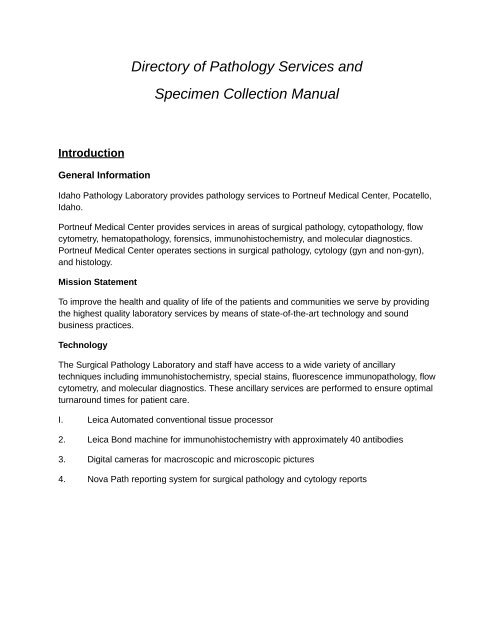
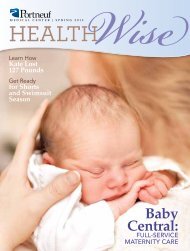

![01-05-2009 Portneuf Medical Center Announces Year ]End ...](https://img.yumpu.com/44745803/1/190x245/01-05-2009-portneuf-medical-center-announces-year-end-.jpg?quality=85)
